Through July 29
Free
USF Contemporary Art Museum
Details here
As an international student at USF since 2017, I’d never been aware of the Contemporary Art Museum on the Tampa campus, just a few steps away from the Marshall Student Center.
No invitations were sent to me as a Literature student, but I think my first visit being destined to happen this month for this exhibition was for a reason. I only recently (since last Fall) studied and became involved in African American history and literature, and it changed my life forever – in the best ways you could think of.
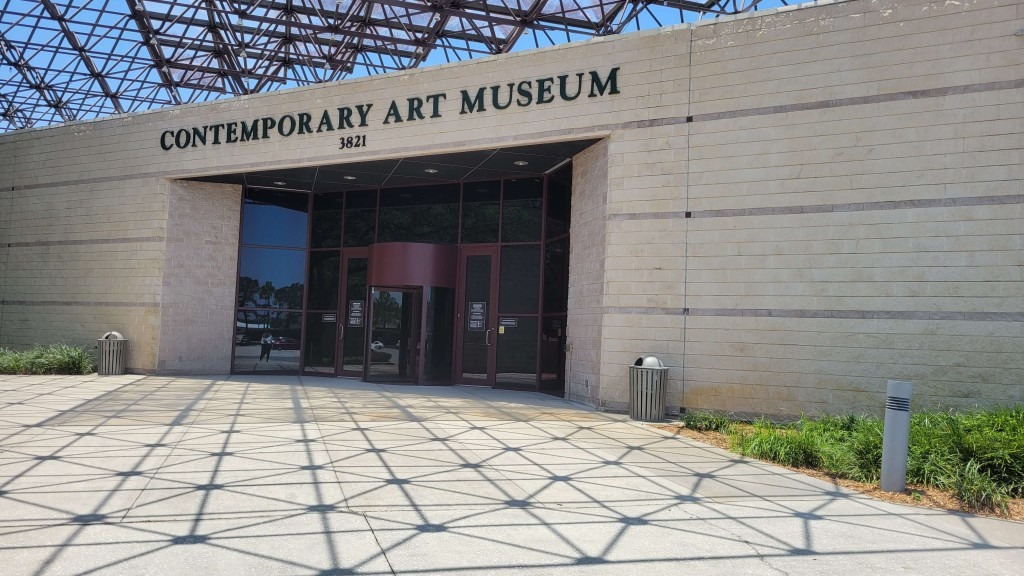
I was ready to go through those rotating doors at the entrance, eager even. The receptionist checked me in, asked for my purse to be placed in a cubby shelf, and I made sure I got my phone and notebook ready to document everything. I was one of a handful of visitors on a Tuesday, and explored the museum from left to right, alone for the last few open hours.
Rico Gatson’s biography and introduction to the theme of the exhibition were laid out on the wall – VISIBLE TIME – while hearing a recorded female voice. All my ears could digest in the distance was “There is time to… a time…”
Don’t worry. My mind comes to hear her clearly before the end of my visitation, and I’ll explain. But this was a chilling start, something I never experienced at a museum before.

The black and white stripes surrounded by colors at the corner of my left eye caught my attention. The colors of the prism are carried by the eyes of the painting – the circles – against black and white pillars, the two triangles touching from side to side bringing a negative color effect to those streaks while darkening the white and bringing luminosity into the black.
The title of this painting, Untitled (Malcom in the Spirit) made me stand in that unmanned hall with a deep curiosity to see this work for what it is. I felt in my spirit that this art represents that no matter the skin color we have on as humans, we all carry different colors – diverse and distinguished in the spirit and buried beneath the surface of flesh.
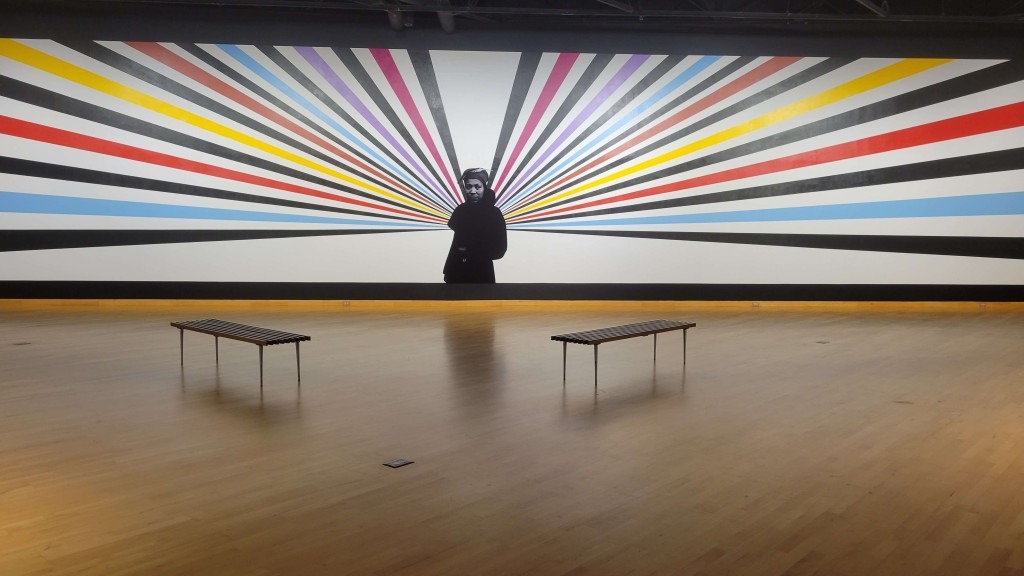
Then, Miss Zora’s name greets me again after parting our ways since December reading. My breath was taken away that there is a full-blown picture of her! She is surrounded by bold colors that accentuate her presence. This mural is enormous, about 15 or 20 feet tall. I was meeting her for the first time here and it had me emotional. As Gatson is also an art teacher, he invited a team of USF students to assist him in painting this tribute to Hurston’s legacy.
Across from Zora Neale Hurston was a collection of frames with figures given a similar presentation, but on paper and downsized to a smaller scale. I do believe each person’s colored lines represent a movement of the soul.
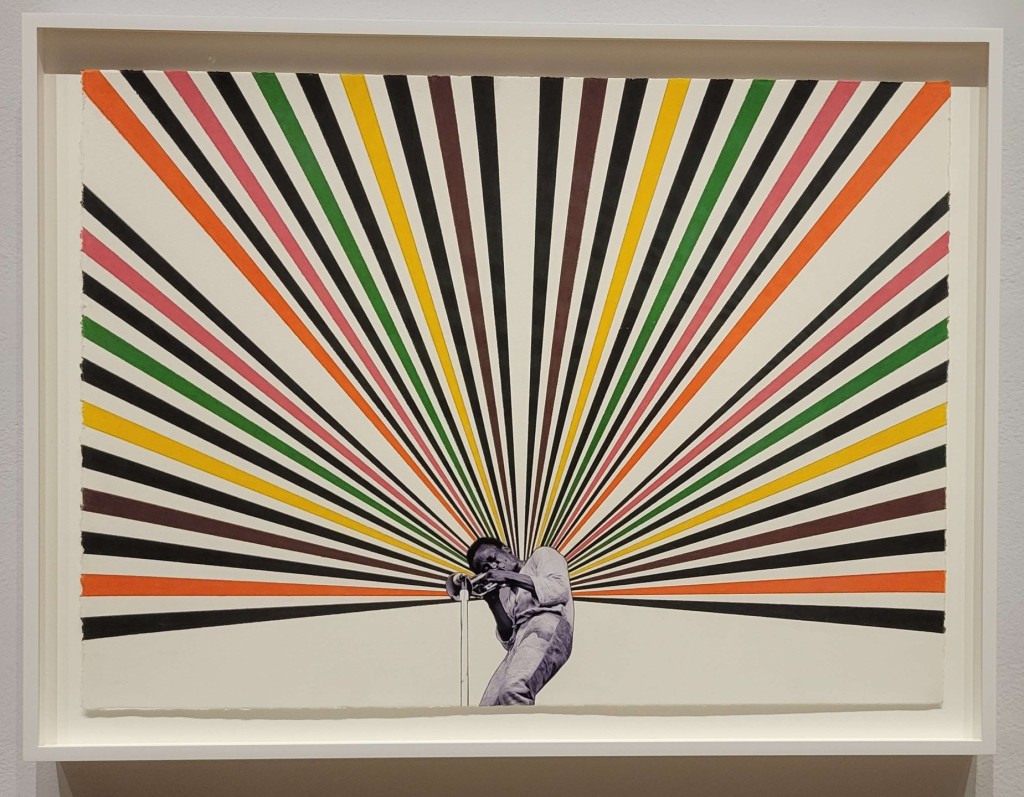
The warm colors radiating from Miles and Don represent the liberation of soulful expression – music. The black bands radiating off of Elbert and Sidney allude to the spirit of protest, while Dick’s red and green take on a statement for bringing change and peace within the Pan-African colors. And Alice’s blue hues present calmness but sadness.

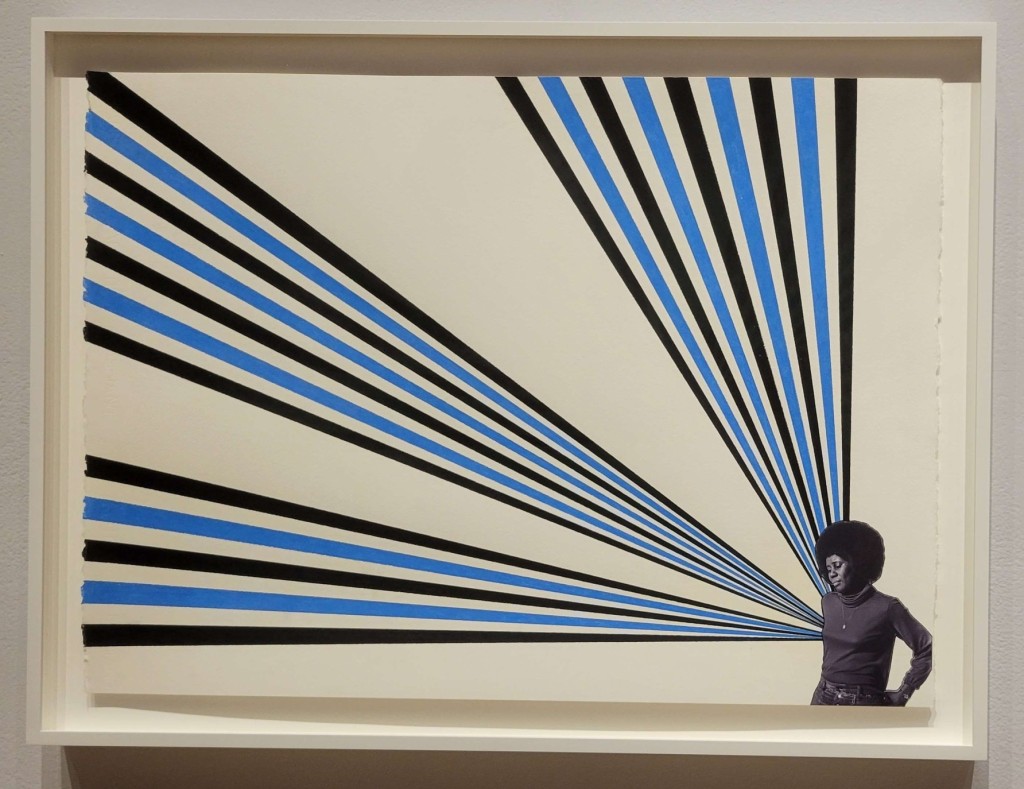
A similar but unique set of these pieces can also be viewed by the reception area with different sets of colors.

You can download a free PDF guide to Rico Gatson: Visible Time here,
including an interview with the artist and the essay “The Healing
Force of the Universe: Using Music to Explore the Art of Rico Gatson”

What sits in between Miss Hurston and these framed-up papers are seven patterned wooden boards leaning against the wall. These vibrant Seven Panels brought a soothing but fun atmosphere to the space. Varied patterns of color blocks, symmetrical and asymmetrical shapes, assimilate harmoniously.
A dark hallway with screens and headphones contrasts with the bright and bold room I was in – three screens, each with two pairs of headphones for listeners. These digital works featured Kaleidoscopic motion-pictures and recordings.
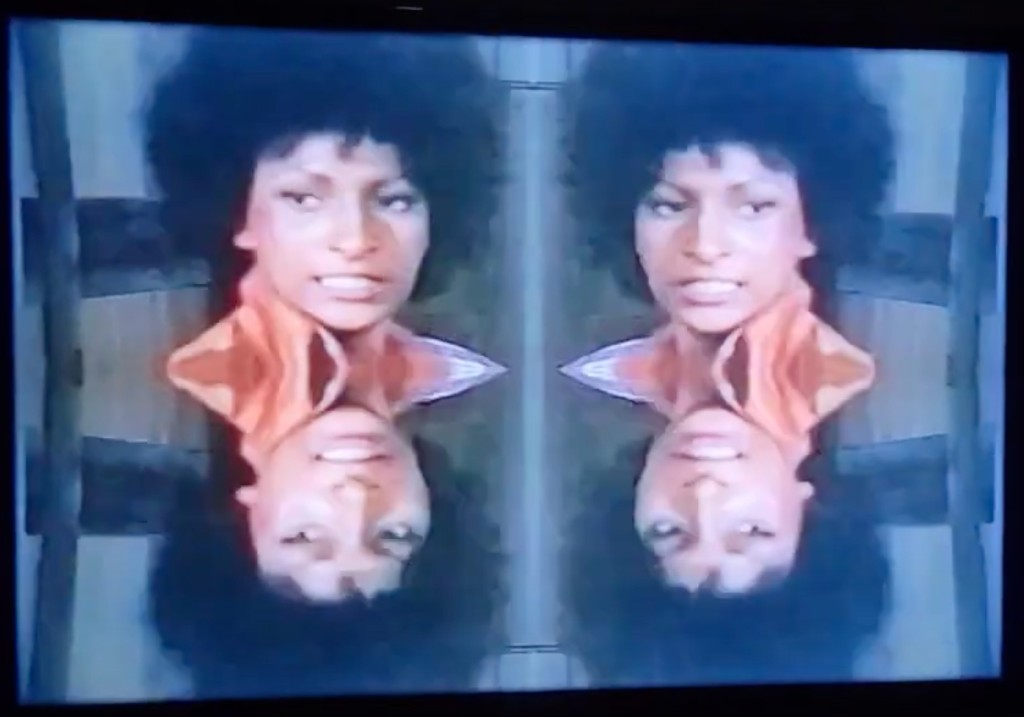
The first, Gun Play, is a series of psychedelic-horror instrumentals with faint, ghostly moans and echoes, that transition to didactic sounds of gunshots, human grunts, screaming, and the rustling of clothing. In this two-minute video, Black characters’ faces are deliberately removed unless they are shown to be hurt or ready to face danger. It ends with two men, one White and the other Black, dying to their gunshots, and a loud scream that fades to nothing.
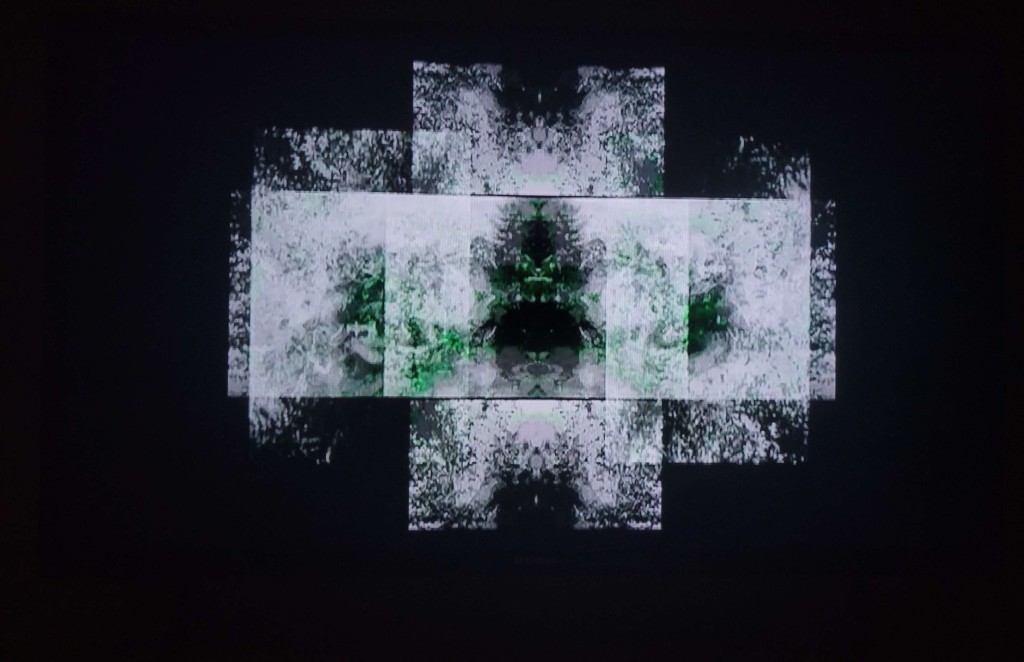
On the second screen, History Lesson starts with the sounds of burning, its frequency aligning with the speed of the video. This work focuses on hypnotizing and psychedelic music that accompanies popping sounds. It felt like I was programmed to view African Americans in a certain way – in another era that only caricaturizes their image, and the sound of time through music moving forward, backwards and spiraling down with a piece of metal dropping on a floor that echoes.
After a brief plain white image appears, Bob Dylan’s song “Only a Pawn in Their Game” plays, with each stock photo appearing to match the lyrics – and especially emphasizing the image of white supremacist Byron De La Beckwith. The video closes by mixing noir-jazz tunes with hallucinogenic pops, high frequencies, clapping, drums and chanting that follow flashing colors of red, white and blue that overlay the pixelated images of the African American folks shown at the start.

I think what Mr. Gatson is trying to convey with this video in particular is that African Americans are caught in a feedback loop of trauma that has no end and has no start, and too many become pawns of the system – that system being the ideologies of hate, racism and deception that control populations and prevent people thinking for themselves.
On the last of the three screens, System Failure uses glitching and error message alerts, and incoherent instruments playing at different paces as multiple pieces of videos are mashed into one. This piece shows me a feeling that Black Communities are stuck with the history of hatred and fear and cannot forget.
An audible voice is inserted – “… stay in that system… because to do otherwise… is to bring genocide [unto us].” This message was foreboding, and quite haunting to take in, which I know is the success of understanding Mr. Gatson’s reasons for making these.
You can take a virtual tour of this exhibit here
Four Stations at the end of this dark hallway is on a very large, borderless screen. This is a recording of Gatson’s trip to Money, Mississippi, where a 14-year-old Black boy named Emmett Till was murdered after being accused of harassing a white woman in 1955. Gatson honors Emmett and his mother with cosmic effects, psychedelic jazz, trumpets and harps, to signify their place in the heavens.
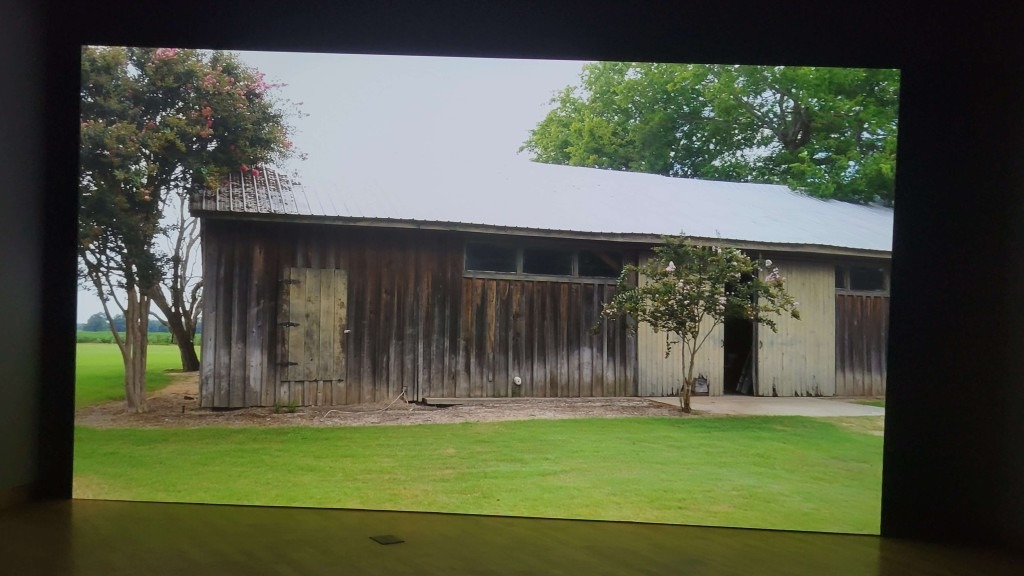
The end of this exhibition focuses on Kathleen Cleaver and her speech for the Black Panthers Party in 1968 after police murdered her 17-year-old son, Bobby Hutton. When She Speaks displays moving Africana-based colored shapes that sometimes flash with the beat of claps, and allow glimpses of her gaze to be noticed.
My journey at this museum ended with Cleaver’s words – “Remember like Solomon. There is a time for everything… a time to hate, a time to fight, and a time to retreat.” Her voice was bold, captivating and strong – focused on the justice she wanted to bring to the young Black man who died in her time.
Rico Gatson gave me an experience I will never forget, because he made me see, feel, listen, and even touch history – and to search it.
His work built yearning in my heart to see beyond the exterior, and to see into the soul of those who have been denied their visibility and excellence throughout the history of America – when they are part of it.
USF Contemporary Art Museum
Free
3821 USF Holly Drive
Tampa FL 33620
Mon-Fri 10 am-5 pm | Thu 10 am-8 pm | Sat 1-4 pm
Closed Sun + Holidays (June 19, July 3-4)
usfcam.usf.edu/CAM






